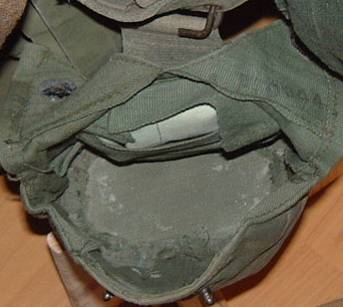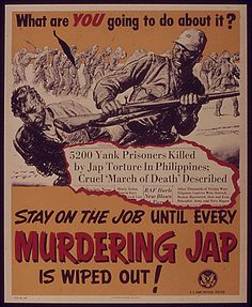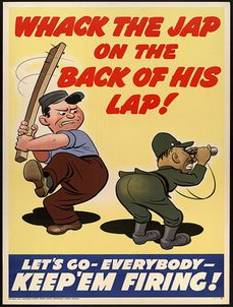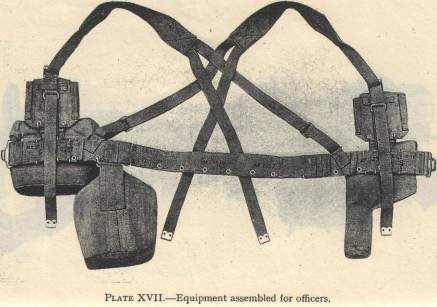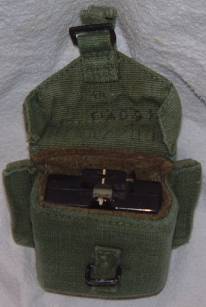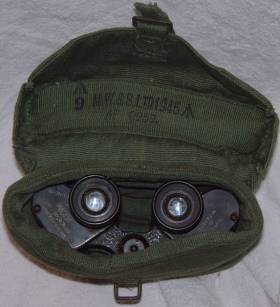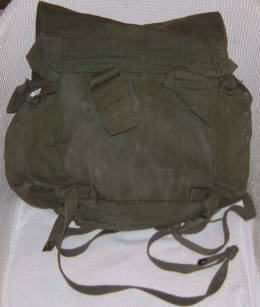|
|
|
Designed for jungle and tropical climates it was Introduced in 1945 just as WW11 ended and was still in use in one form or another until it was replaced by PLCE pattern 90.
It was mainly tropical theater issue only. It was used in campaigns in the Korean war,the Malayan emergency, in Kenya against the Mau-Mau , far East campaigns and the Suez .
The only formations to use the p44 webbing all the time no matter were they were fighting was the airborne and paratroopers.
|
Patt 44 belt unissued. Note the three part construction which was previously used in the patt 19 and 25 web sets.
Also note the loop on the left hand side . The picture on the right shows the loop being used for holding the narrow part of the rifle butt when the weapon was slung.
I have several of these without the loop. From what I can tell they were ripped off as soon as the soldiers got in the field. It comes in two sizes normal and large.
|
|
|
Patt 44 yoke or braces dated 1945 . The two front 1 inch straps fit to the top of the basic pouch's or the brace attachments as shown in the first picture.
The second picture shows how the back four 1 inch straps are attached to the belt . Two to the back and one to each side.
The third picture is from the patt 44 instruction manual 1946 it is of the inside of the pat44 equipment and shows the braces attached to the brace attachments and belt more clearly. |
|
|
Patt 44 water bottle cup and cover dated 1945. There are two versions of patt 44 water bottle the one in the pictures is the first one with the aluminum cap the second one has a black rubber cap. Note the folding handles on the cup .
On the inside of carrier on the back there is a pocket and loop. The pocket is for the milbank water filtration bag and the loop is for a bottle of water sterilization tablets see third picture.
[ to see the milbank water filtration bag go to miscellaneous equipment ]. |
|
|
Patt 44 bayonet frog dated 1945. The bayonet frog has a woven hole in the upper scabbard loop to enable the No. 4 No.5 or No. 7 bayonet to be carried by inserting the stud though the hole.
The No. 1 bayonet is held in the frog by the stud on the scabbard being inserted between the web loops. A narrow web loop is provided at the top of the frog to slip over the hilt of the No. 1 or the No.5 bayonet to stop it swinging.
|
|
Patt 44 brace attachments.
Brace attachments are issued for the use of those not equipped with basic pouches or with only one basic pouch such as
Officers, Warrant Officers, N.C.Os. And Specialists.
|
|
|
Patt 44 pistol case dated 1945. For use with the standard 38inch revolver.
Note the reinforced bottom were there is also a drainage hole.
On the back of the holster it has two double hooks for attachment to the waist belt as well as a hanger hook to attach to the ammunition pouch when that article is to be carried above the pistol case,
or to serve as a alternative method of attachment to the waist belt.The picture on the right shows it attached to the belt and the ammunition pouch. |
|
|
Patt 44 pistol ammunition pouch dated 1945. In the flange at the bottom two grommets are fitted for attachment to the pistol case and on the back two vertical web loops for carrying on the belt in an alternative position,
a horizontal loop is fitted to pass over the brace attachment.
The picture of the officer shows one possible position for the pouch on the right of the picture above the holster.
|
|
Patt 44 compass pouch. The picture of the officer shows one possible position above the binoculars case on the right of the picture.
The picture of the officer above shows it on the left. It is identical to the ammunition pouch from the outside the only difference is the compass pouch has extra padding and a stiffener to protect the compass. |
|
|
Patt 44 binocular case dated 1945. Made of a double shell of webbing interlined with felt a fiber stiffening is fitted to the base .
On the back of the case it has two double hooks for attachment to the waist belt as well as a hanger hook to attach to the compass pouch when that article is to be carried above the binocular case
or to serve as a alternative method of attachment to the waist belt. |
|
|
Pattern 44 Officers haversack dated 1945.
Note the single buckle closure ,carrying handle and suspension buckles that allowed the haversack to
be to the brace ends. The interior has only one compartment and a waterproof lining. |
|
|
Patt 44 haversack / small pack dated 1946. The haversack has one large compartment and two pockets attached one to ether side.
One pocket for the mess tins and the other for rations or small kit. The main inside compartment has a water proof lining [see the first picture].
There are two buckles at the top one ether side just above the side pockets which attach to the braces when worn on the side while carrying the rucksack or large pack on the back.
When worn on the back left and right shoulder straps / L straps are used [see second picture] which attach to the back of the haversack using the top 2 inch wide tabs and the two bottom buckles.
The hook at the corner of the L strap attaches to the top of the basic pouches or the brace attachments when worn .
On the front of the haversack there are two horizontal straps one on the flap the other on the bottom edge [see third picture] which holds the shaft of a Shovel or pick.
There are two straps sown to the bottom edge at the back which thread round the chest and through the web loops at the back of the basic pouches or the brace attachments and connect at the front.
There are two sets of straps on the base of the haversack which are used to carry bedding or poncho. |
Second pattern haversack dated 1967. Introduced in the early 60s ? Some times called the large pack it is basically just a larger version of the first patten haversack with additional loops and hooks on the outside of the flap for attaching equipment plus a buckle and strap on the inside of the flap to close the inside compartment. The two side pouches are closed with twist fasteners instead of the quick release fasteners.
Patt 44 basic pouches . They come in left and right pairs the left hand pouch has loops on the side for carrying the no 4, 5 or 7 bayonets.
The quick - release fastener on the flaps can be fastened to one of two links on the front of the pouch. The bottom one for standard size items and the upper link is used when larger items are carried.
There are two patterns of basic pouches the main difference between them are the second pattern has a second pair of belt attachment hooks so they can be worn lower down [see forth picture].
Patt 44 basic pouch M.T.drivers. This is similar in size and construction to the left basic pouch
except that in place of the metal belt attachments on the back a 2-inch wide web loop is provided to enable it to be carried on the waistbelt
to the rear of the brace attachment.see pictures.
 BACK TO MILITARY EQUIPMENT BACK TO MILITARY EQUIPMENT |
|










